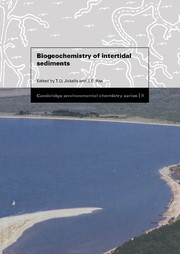Book contents
- Frontmatter
- Contents
- List of contributors
- Preface
- 1 Biogeochemistry of intertidal sediments
- 2 Trace metals in deposited intertidal sediments
- 3 Modelling adsorption and desorption processes in estuaries
- 4 A critical appraisal of the methodology used in studies of material flux between saltmarshes and coastal waters
- 5 Nutrient recycling in intertidal sediments
- 6 An overview of carbon and sulphur cycling in marine sediments
- 7 Microbial activity and diagenesis in saltmarsh sediments, North Norfolk, England
- 8 The behaviour of radionuclides in the coastal and estuarine environments of the Irish Sea
- 9 The sorption of hydrophobic pyrethroid insecticides to estuarine particles: a compilation of recent research
- Index
2 - Trace metals in deposited intertidal sediments
Published online by Cambridge University Press: 23 September 2009
- Frontmatter
- Contents
- List of contributors
- Preface
- 1 Biogeochemistry of intertidal sediments
- 2 Trace metals in deposited intertidal sediments
- 3 Modelling adsorption and desorption processes in estuaries
- 4 A critical appraisal of the methodology used in studies of material flux between saltmarshes and coastal waters
- 5 Nutrient recycling in intertidal sediments
- 6 An overview of carbon and sulphur cycling in marine sediments
- 7 Microbial activity and diagenesis in saltmarsh sediments, North Norfolk, England
- 8 The behaviour of radionuclides in the coastal and estuarine environments of the Irish Sea
- 9 The sorption of hydrophobic pyrethroid insecticides to estuarine particles: a compilation of recent research
- Index
Summary
Introduction
Trace metals, for example elements from the first row of transition metals including cobalt, nickel, copper and zinc (Co, Ni, Cu and Zn), occur naturally in intertidal sediments. The natural (or ‘background’ inputs) reflect a combination of the composition of drainage-basin rocks and marine-derived sediment. The global anthropogenic input of many trace metals to the environment currently equals or exceeds the amount released by weathering (de Groot, Salomons & Allersma, 1976), and the extent of anthropogenic influence in intertidal sediments is particularly high, since intertidal areas are often considered as convenient dumping grounds for industrial and other waste.
Anthropogenic inputs to intertidal environments are often direct, through point-source waste disposal, but they are also indirect, from riverine, marine and/or atmospheric sources. Trace metals are partitioned between each component of the intertidal sediment–water system: they are found in solution (‘bulk’ water or interstitial water) and associated with suspended and deposited sediments. This chapter is concerned with the biogeochemistry of trace metals in deposited intertidal sediments. Two main sections follow: in the first, an overview of surface sediments and sediment depth profiles is presented, and in the second, a case study is given of the historic record of Zn from saltmarsh sediments in the Severn Estuary, UK.
- Type
- Chapter
- Information
- Biogeochemistry of Intertidal Sediments , pp. 16 - 41Publisher: Cambridge University PressPrint publication year: 1997
- 8
- Cited by



